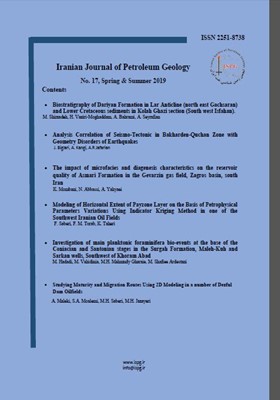Investigation of main planktonic foraminifera bio-events at the base of the Coniacian and Santonian stages in the Surgah Formation, Maleh-Kuh and Sarkan wells, South west of Khoram Abad
Subject Areas : شاخه های دیگر علوم زمین در ارتباط با زمین شناسی نفتMohammad Hadadi 1 , Meysam Shafiee Ardestani 2 , Mohammad Vahidinia 3 * , Mohammad Gharaee 4
1 - Ferdosi University
2 - Ferdosi University
3 - Ferdosi University
4 - Ferdosi University
Keywords: Zagros sedimentary basin Surgah Formation Planktonic foraminifera bioevents Turonian-Coniacian boundary ,
Abstract :
In this study Surgah Formation at Maleh-Kuh and Sarkan section in south west of Khoram Abad have been studied based on bio-event models. Surgah Formation at Sarkan well no.1and Maleh-Kuh has 46 and 82-meter thickness respectively and was placed on the Sarvak Formation and under the Ilam Formation. In this study Surgah Formation were composed of shale, limy shale with glauconite and pyrite. In this section two Turonian-Coniacian and Coniacian-Santonian boundaries were recognized in Dicarinella concavata Interval Zone. Based of Heterohelix moremani and FODs Dicarinella concavata and Dicarinella primitiva were detected Turonian-Coniacian boundary. Finally based on LoDs Dicarinella primitiva and Marginotruncana marginata were distinguished Coniacian - Santonian boundary in this section.

